 An extended Coloured family with roots in Cape Town, Kimberley and Pretoria | |
| Total population | |
|---|---|
| 5,600,000~ in Southern Africa | |
| Regions with significant populations | |
| South Africa, Namibia, Botswana, Zimbabwe | |
| 5,052,349 (2022 census)[1] | |
| 107,855 (2023 census)[2][a] | |
| 14,130 (2022 census)[3] | |
| 3,000 (2012 census)[4] | |
| Languages | |
| Afrikaans, English, IsiXhosa, Setswana[5] | |
| Religion | |
| Predominantly Christianity, minority Islam | |
| Related ethnic groups | |
| Africans, Mulatto, White South Africans, Afrikaners, Boers, Cape Dutch, Cape Coloureds, Cape Malays, Griquas, San people, Khoikhoi, Zulu, Xhosa, Saint Helenians, Rehoboth Basters, Tswana | |

- 0–20%
- 20–40%
- 40–60%
- 60–80%
- 80–100%

- <1 /km2
- 1–3 /km2
- 3–10 /km2
- 10–30 /km2
- 30–100 /km2
- 100–300 /km2
- 300–1000 /km2
- 1000–3000 /km2
- >3000 /km2

Coloureds (Afrikaans: Kleurlinge) are members of multiracial ethnic communities in South Africa, Namibia and to a lesser extent, Zimbabwe and Zambia who have ancestry from African, European, and Asian people. The intermixing of different races began in the Dutch Cape Colony of South Africa, with European settlers intermixing with the indigenous Khoi tribes, and Asian slaves of the region. Later various other European nationals also contributed to the growing mixed race people, who would later be officially classified as coloured by the apartheid government in the 1950s.[7][8]
Coloured was a legally defined racial classification during apartheid referring to anyone not white or of the black Bantu tribes, which effectively largely meant people of colour.[8][9]
In the Western Cape, a distinctive Cape Coloured and affiliated Cape Malay culture developed. Genetic studies suggest the group has the highest levels of mixed ancestry in the world.
The majority of coloureds are found in the Western Cape but are prevalent throughout the country. In Cape Town, they form 43.2% of the total population, according to the South African National Census of 2011.[10]: 11, 57
The apartheid-era Population Registration Act, 1950 and subsequent amendments, codified the Coloured identity and defined its subgroups, including Cape Coloureds and Malays. Indian South Africans were initially classified under the act as a subgroup of Coloured.[11] As a consequence of Apartheid policies and despite the abolition of the Population Registration Act in 1991, Coloureds are regarded as one of four race groups in South Africa. These groups (blacks, whites, Coloureds and Indians) still tend to have strong racial identities and to classify themselves and others as members of these race groups.[9][8] The classification continues to persist in government policy, to an extent, as a result of attempts at redress such as Black Economic Empowerment and Employment Equity.[8][12][13]
- ^ "Census 2022 Statistical Release" (PDF). Statistics South Africa. Retrieved 2024-11-01.
- ^ "Namibia 2023 Population and Housing Census Main Report" (PDF). Namibia Statistics Agency. Retrieved 2024-10-30.
- ^ "Zimbabwe 2022 Population and Housing Census Report, vol. 1" (PDF). ZimStat. Zimbabwe National Statistics Agency. p. 122. Archived from the original (PDF) on 1 October 2024.
- ^ Milner-Thornton, Juliette Bridgette (2012). The Long Shadow of the British Empire: The Ongoing Legacies of Race and Class in Zambia. Palgrave Macmillan. pp. 9–15. ISBN 978-1-349-34284-6.[permanent dead link]
- ^ Alexander, Mary (2019-06-09). "What languages do black, coloured, Indian and white South Africans speak?". South Africa Gateway. Retrieved 2024-06-15.
- ^ Calafell, Francesc; Daya, Michelle; van der Merwe, Lize; Galal, Ushma; Möller, Marlo; Salie, Muneeb; Chimusa, Emile R.; Galanter, Joshua M.; van Helden, Paul D.; Henn, Brenna M.; Gignoux, Chris R.; Hoal, Eileen (2013). "A Panel of Ancestry Informative Markers for the Complex Five-Way Admixed South African Coloured Population". PLOS ONE. 8 (12): e82224. Bibcode:2013PLoSO...882224D. doi:10.1371/journal.pone.0082224. ISSN 1932-6203. PMC 3869660. PMID 24376522.
- ^ "coloured". Oxford Dictionaries. Oxford University. Archived from the original on March 9, 2014. Retrieved 14 April 2014.
- ^ a b c d Posel, Deborah (2001). "What's in a name? Racial categorisations under apartheid and their afterlife" (PDF). Transformation: 50–74. ISSN 0258-7696. Archived from the original (PDF) on 2006-11-08.
- ^ a b Pillay, Kathryn (2019). "Indian Identity in South Africa". The Palgrave Handbook of Ethnicity. pp. 77–92. doi:10.1007/978-981-13-2898-5_9. ISBN 978-981-13-2897-8.
- ^ Census 2011 Municipal report: Western Cape (PDF). Statistics South Africa. 2012. ISBN 978-0-621-41459-2. Archived from the original (PDF) on 13 November 2015. Retrieved 30 November 2016.
- ^ "1950. Population Registration Act No 30 - the O'Malley Archives".
- ^ "Manyi: 'Over-supply' of coloureds in Western Cape". February 24, 2011.
- ^ "BBC News - How race still colours South African elections". BBC News. April 20, 2011. Archived from the original on November 20, 2014.
Cite error: There are <ref group=lower-alpha> tags or {{efn}} templates on this page, but the references will not show without a {{reflist|group=lower-alpha}} template or {{notelist}} template (see the help page).